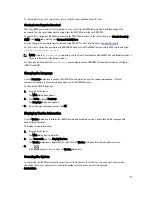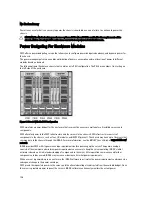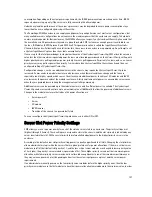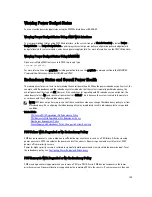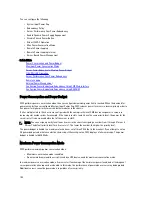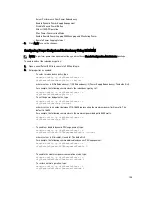
PSU, CMC evaluates power needs again when the second PSU is removed to determine the firmware response. If power
requirements are still not met, CMC may power off the lower priority servers.
Limits
•
CMC does not support
automated
power-down of a lower priority server to allow power up of a higher priority
server; however, you can perform user-initiated power-downs.
•
Changes to the PSU redundancy policy are limited by the number of PSUs in the chassis. You can select any of
the three PSU redundancy configuration settings listed in
Default Redundancy Configuration
.
New Server Engagement Policy
When a new server is powered on, CMC may need to decrease power to lower priority servers to allow more power for
the new server if adding the new server exceeds the power available for the chassis. This could happen if the
administrator has configured a power limit for the chassis that is below what would be required for full power allocation
to the servers, or if insufficient power is available for the worst-case power need of all servers in the chassis. If enough
power cannot be freed by reducing the allocated power of the lower priority servers, the new server may not be allowed
to power up.
The highest amount of sustained power required to run the chassis and all of the servers, including the new one, at full
power is the worst-case power requirement. If that amount of power is available, then no servers are allocated power
that is less than the worst-case power needed and the new server is allowed to power up.
If the worst-case power requirement cannot be met, power is reduced to the lower priority servers until enough power
is freed to power up the new server.
The following table provides the actions taken by CMC when a new server is powered on in the scenario described
earlier.
Table 35. CMC Response When a Server Power-On is Attempted
Worst Case Power is Available
CMC Response
Server Power On
Yes
No power conservation is required
Allowed
No
Perform power conservation:
•
Power required for new server is available
•
Power required for new server is not available
Allowed
Disallowed
If a PSU fails, it results in a non-critical health state and a PSU failure event is generated. The removal of a PSU results
in a PSU removal event.
If either event results in a loss of redundancy, based on power allocations, a
loss of redundancy
event is generated.
If the subsequent power capacity or the user power capacity is greater than the server allocations, servers have
degraded performance or, in a worse case, servers may be powered down. Both conditions are in reverse-priority order,
that is, the lower priority servers are powered down first.
The following table provides the firmware response to a PSU power down or removal as it applies to various PSU
redundancy configurations.
Table 36. Chassis Impact from PSU Failure or Removal
PSU Configuration
Dynamic PSU
Engagement
Firmware Response
AC Redundancy
Disabled
CMC alerts you of loss of AC Redundancy.
Power Supply
Redundancy
Disabled
CMC alerts you of loss of Power Supply Redundancy.
190
Содержание Chassis Management Controller
Страница 1: ...Dell Chassis Management Controller Firmware Version 4 3 User s Guide ...
Страница 42: ...42 ...
Страница 56: ...56 ...
Страница 84: ...84 ...
Страница 98: ...98 ...
Страница 104: ...104 ...
Страница 130: ...130 ...
Страница 136: ...136 ...
Страница 200: ...200 ...
Страница 214: ...214 ...


